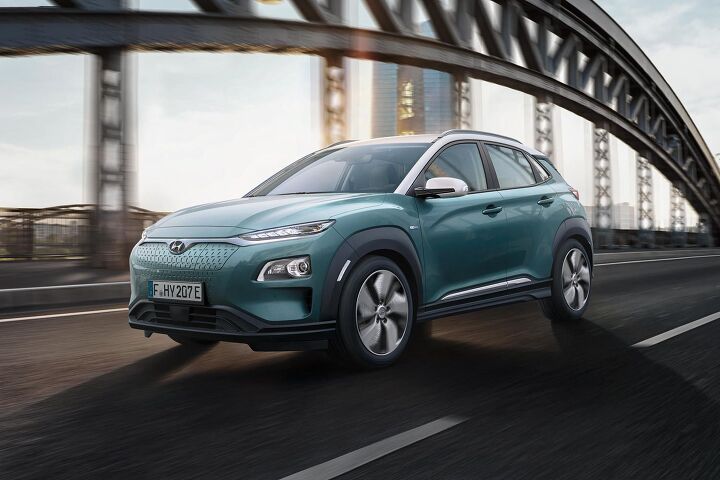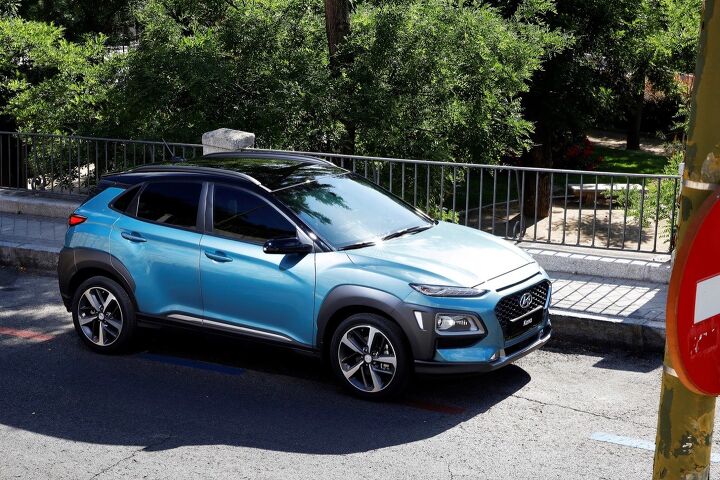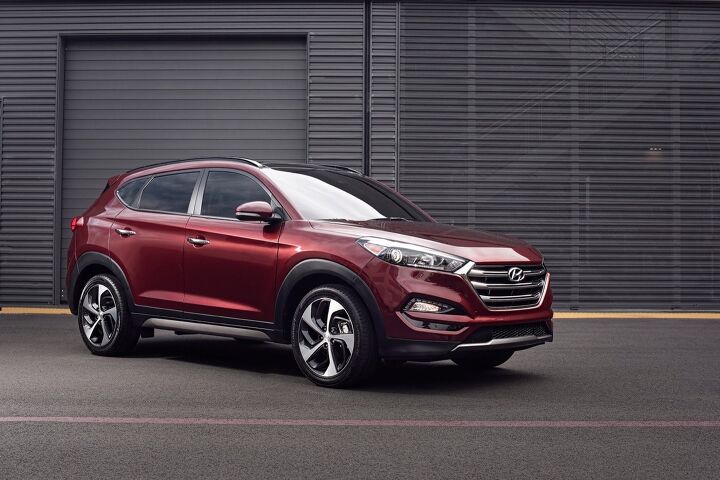#HyundaiKona
Ace of Base: 2018 Hyundai Kona
Earlier this year, Hyundai mixed up the nomenclature of its largest crossover. The three-row Santa Fe XL takes the place of the old three-row Santa Fe, with that name migrating to the smaller machine (which is only available as a two-row unit unless you opt for the diesel, in which case it’s a three-row, but not an XL). Understand?
No, me either. What I do know is the littlest crossover in Hyundai dealerships is no longer the Tucson. Enter the Kona, a pint-sized ute ready to take on competitors like the CX-3 and HR-V. The Korean automaker usually runs long on features and short on price, so let’s find out what its newest nameplate offers in the sub-$20,000 range.
Is Hyundai's Electric Kona the EV North America Has Been Waiting For?
Range anxiety remains the primary reason why most people don’t want to purchase an electric car. However, the overall recipe for today’s battery electric vehicles feels counter to what consumers are demanding. In the United States, all the top-selling electrics are whatever sedan or hatchback has a superior range. But, excluding the pricy Model X, there isn’t a single SUV or crossover among them (the Soul EV doesn’t count). Odd, considering that’s the body style most people are clamoring for right now.
That’s what makes Hyundai’s decision not to send the all-electric Kona immediately to North America a bit perplexing. We understand the brand probably feels some trepidation over sending another green car to the U.S. After all, the Ioniq could have performed better in its rookie year — despite being a totally serviceable alternative to Toyota’s Prius (as a hybrid) or Nissan’s Leaf (as a battery electric).
But the Kona EV has the potential to take the niche EV market by storm. Not only would it be the only electrified crossover that doesn’t require a lofty financial investment, it would also have an enviable range. More than enough to best the Chevrolet Bolt on a lengthy road trip, in fact.
That Awful Hyundai Kona Lease? It's Already Dead
Mere hours after we published a story on the attractively priced but awful-to-lease Hyundai Kona yesterday, it seems Hyundai had a change of heart.
The initial advertised lease for the volume SEL trim lasted less than a week, after the automaker apparently decided it wasn’t a good thing to make the brand’s smallest crossover more expensive to lease than the larger Tucson and Santa Fe Sport.
Hyundai Kona Rolls Out of the Gate With a Less-than-ideal Lease
As we told you earlier this month, Hyundai’s newest offering, the B-segment Kona crossover, arrived with a base price below that of its subcompact competition. At $20,450 after delivery for a base, front-drive SE, the Kona slots below the entry MSRPs of the Honda HR-V, Toyota C-HR, Chevrolet Trax, and Mazda CX-3.
Value, the Kona trumpets, has arrived.
Well, not if you’re leasing the Kona’s volume trim: the SEL model.
Fuel Economy Figures Released for Hyundai's Littlest Crossover
Hyundai’s smallest utility vehicle arrives as the automaker tries to put a troubling year behind it. Sales fell significantly in both the U.S. and Canada in 2017, the first annual drop since the recession. The blame for the 13.4 percent U.S. drop and 6.1 percent Canadian decline lies in our growing aversion to small, fuel-efficient cars, of which Hyundai has many, and our insatiable lust for large utility vehicles, of which Hyundai does not have enough.
There’s nothing large about the Hyundai Kona, but it’s still an important player in the raft of new or revamped crossovers bound for Hyundai’s stable. And, just like in the small car segment it’s slowly replacing, economy matters in the small crossover segment. So, now that the Environmental Protection Agency has seen fit to test the Kona, how does its thirst stack up against its rivals?
Hyundai's Labor Issues Return as Kona Production Stops Prior to U.S. Launch
Hyundai Motor Company has, once again, found itself at the mercy of an unhappy workforce. No stranger to labor disputes, the company hinted that it might scale back its at-home labor in South Korea — presumably aware that the possible response would be negative, which it was. But the timing couldn’t be worse.
The Kona crossover is believed to be the model that will turn things around for Hyundai in the United States, but a new labor strike has put the export vehicle’s production on hold only a week after it started.
Hyundai Lays Out Its Crossover Plan; Eight CUVs on the Way
After being caught off guard by the American public’s thirst for high-riding, commodious, all-weather vehicles, Hyundai’s planning to make up for lost time.
As part of an effort we’ve known about for a year, Hyundai laid its “build more crossovers” strategy bare on Wednesday. Including the subcompact 2018 Kona, which lands on U.S. shores early next year, the automaker will “debut” eight new or redesigned CUVs over the next two years. Unfortunately, details are threadbare.
Going from Hyundai’s product timeline, the future lineup includes (among others) a new A-segment crossover, a diesel model, and an electric. Already burned, Hyundai’s now covering its bases.
Searching for Volume, Hyundai Considering Bringing More Vehicles Stateside: Report
Hyundai says it hasn’t made a decision one way or the other, but a South Korean publication claims company officials are considering a huge U.S. production push, all designed to reverse falling sales.
Reported by Seoul Economic Daily, the tentative plan (leaked by anonymous industry officials) is all about getting more utility vehicles into the hands of American buyers. It would see U.S.-market Tucson and Kona crossovers, currently built in Korea, move assembly to Montgomery, Alabama. A pickup truck would follow.
There Just Might Be a Kona Under the Tree This Christmas
Desperate eager to fill holes in its product lineup and put some bounce in its sales step, Hyundai unveiled the subcompact Kona crossover earlier this year, with the model arriving on North American shores in the first quarter of 2018. The Kona is just one part of Hyundai’s revamp of its crossover lineup — and its culture.
More crossovers, bigger and smaller crossovers, EV crossovers, and faster crossovers make up Hyundai’s short-term goals. By “faster,” we’re referring to the development cycle, unless the brand has some hot “N” action waiting for one of its cargo-friendly models. Caught off guard by the utility vehicle craze, Hyundai wants to pare its product planning window down from three years to a year-and-a-half, allowing a quicker response to new market trends.
But the first step towards a more agile Hyundai Motor Company is the Kona. Small, cladded, and efficient, the 2018 Kona might arrive sooner than planned.
Hyundai Hopes to Solve U.S. Sales Woes With Slick Little Pickup
Hyundai intends to launch a small pickup truck in the United States as part of its plan to catch up with the industry’s shift away from sedans. Up until now, that strategy has involved cramming as many SUVs onto the market as possible. But Hyundai brand sales are still dragging behind 2016’s monthly averages in the U.S., with end-of-year estimates falling short of company goals.
The solution is to keep pushing the Tucson, start deliveries on the Kona mini SUV before 2018, and begin development of a pickup truck based on the Santa Cruz concept from 2015 (seen above). Hyundai is also rumored to be planning on adding three additional sport utility vehicles or crossovers to its North American lineup by 2020 — helping it shore up waning sedan and hatchback sales.
Hyundai Kona Previews Future Designs, But Don't Expect Russian Dolls
“Each model will have its own identity.” – Luc Donckerwolke,
senior vice president, head of Hyundai Motor Design Center
Finally, long after the Nissan Juke, Subaru Crosstrek, Chevrolet Trax, Jeep Renegade, Honda HR-V, and Mazda CX-3, Hyundai is ready to launch the Kona subcompact crossover, at least in moderate volumes.
The Hyundai Kona is hardly a Tucson Lite; not remotely an Accent Allroad. An unusual face and bizarre use of cladding are all the more obvious because of the Kona’s tidy dimensions.
But while the 2018 Kona showcases a new Hyundai utility vehicle design language, Hyundai’s design leadership promises that future models won’t merely be enlargements of the same.
2018 Hyundai Kona: Late But Not Too Late, Little But Not As Little As The Next One
Nearly seven years after the Nissan Juke. Five years after the Buick Encore. Three years after the Jeep Renegade. Two and a half years after the Honda HR-V. Finally, the 2018 Hyundai Kona is set to arrive as the fourth and smallest member of Hyundai’s utility vehicle lineup.
With the silhouette of a Mazda CX-3, the quirky light treatment of a Nissan Juke, and the cladding of a Pontiac Vibe, the Hyundai Kona will arrive in North America in early 2018 with optional all-wheel drive and a new platform that will be shared with the unfortunately named Kia Stonic.
The platform, Hyundai says, “is optimized to permit SUV levels of ground clearance.” Don’t expect more than 6.7 inches, yet in the Kona’s segment, the little Hyundai won’t actually be that low. But it is small. At 164 inches from bumper to bumper, the Hyundai Kona stretches only two inches longer than a Hyundai Accent hatchback and is four inches shorter than the Mazda CX-3.
Yet by 2020, Hyundai intends to strengthen its crossover lineup by positioning below the B-segment Kona an even smaller A-segment utility vehicle. Like a sidecar for your Santa Fe.
Not So Scantily Clad: 2018 Hyundai Kona Accidentally Drops the Towel
The 2018 Hyundai Kona, which American subcompact crossover aficionados will be able to drool over in person in early 2018, will see its first spotlights during a Korean launch event tomorrow. However, much like private celebrity photographs, the Kona has bared all on the internet a day before the big reveal.
Hyundai hasn’t provided much in the way of specifications, though it has teased us with ever-revealing photos of its new global model for some time. For the automaker, a B-segment crossover isn’t timely — it’s overdue. Utility vehicles are the company’s top focus as the market moves away from the vehicles that sent Hyundai sales surging in the post-recession era.
So, what do you think?
Hyundai's Subcompact Crossover Has a Name: 'Kona'
After its skyrocketing post-recessions sales hit a roadblock in the United States, Hyundai can’t wait to sell Americans more crossovers. It just needs to build them first.
While the Korean automaker already has plans to tinker around with its existing utility lineup, it lacks product on the small end of the scale, which currently gives rivals an edge.
Well, not for long.
Today, Hyundai revealed the name that will soon join the subcompact CUV fray — Kona. Overseas markets will see the Kona in the second half of this year, but those all-important U.S. buyers will have to wait just a little while longer.



























Recent Comments